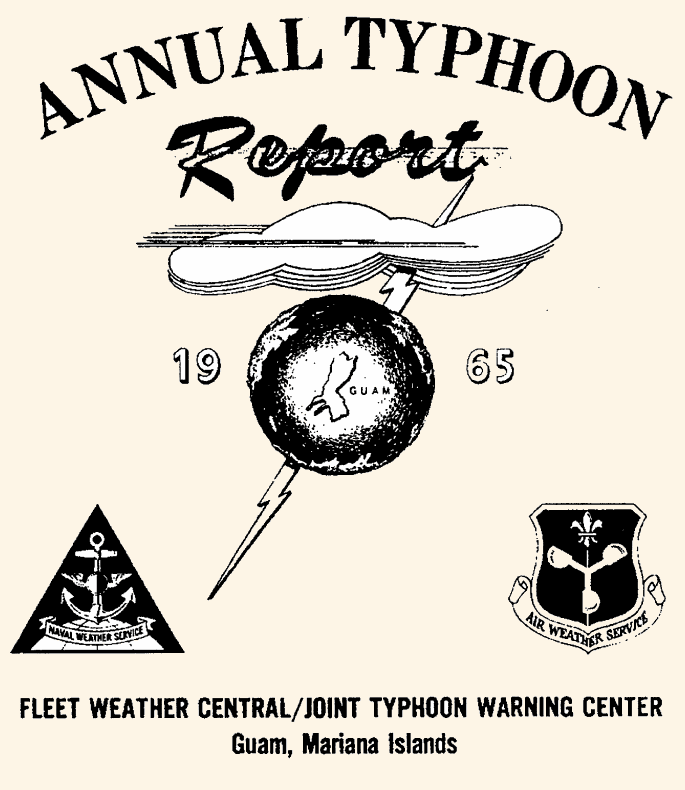
Page Updated 06/27/05

JTWC 1965 Chapter 1
- A. GENERAL
- Within the Fleet Weather Central/Joint Typhoon Warning Center (FWC/JTWC), the basic analysis is the responsibility of the Fleet Weather Central (FWC). Micro-analysis, forecast aid evaluation and the warnings described below are the functions of the Joint Typhoon Warning Center (JTWC). Basic chart prognoses that are received from Fleet Numerical Weather Facility (FNWF), Monterey, California, are utilized, in addition to locally prepared progs.
- B. ANALYSIS
- 1. FWC
- a. Types of contour (c) and/or streamline (s) charts with standard times:
- (1) Surface; 0000Z, 0600Z, 1200Z and 1800Z (c).
- (2) Gradient level (2000 to 3000 ft. above ground); 0000Z, 1800Z. (s)
- (3) 850mb; 0000Z and 1200Z (s).
- (4) 700mb; 0000Z and 1200Z (s) & (c).
- (5) 500mb; 0000Z and 1200Z (s) & (c)
- (6) 300mb; 0000Z and 1200Z (c).
- (7) 200mb; 0000Z and 1200Z (s)
- (8) Sea Surface Temperature Chart; 5-day mean composite updated once daily.
- b. Cross sections for selected tropical Pacific stations
- (1) Checkerboards or Stidd Diagram.
- (2) Time Cross Sections
- 2. JTWC
- a. Micro-analysis:
- (1) Sectional charts; hourly and 3-hourly as required.
- (2) Reconnaissance reports.
- (3) 700mb; 0000Z and 1200Z, 10-meter interval analysis (c).
- (4) 500mb; 0000Z and 1200Z, 20-meter interval analysis (c).
- b. Satellite data. (See Chapter II for details).
- C. FORECAST AIDS
- These are listed in alphabetical order and priority of importance is not indicated.
- bottom of page 9
-
- 1. Climatology
- In preparation for issuance of the initial warning on a tropical cyclone, a track based on climatology is developed. This track is prepared for a time interval of 4 or 5 days at the speed indicated by climatology. The following climatological publications are utilized when constructing the original forecast track for each cyclone:
-
- a. Climatological Aid to Forecasting Typhoon Movement (1st Weather Wing)
- b. Annual Typhoon Report, 1964 (covering years 1953-1964; FWC/JTWC)
- c. Western Pacific Typhoon Tracks 1950-1959 (FWC/JTWC)
- d. Far East Climatic Atlas (1st Weather Wing - February 1963)
- Tropical Cyclones in the Western Pacific and China Sea Area (Royal Observatory, Hong Kong). This comprehensive publication covers 78 years of typhoon tracks. Next, the track is modified in accordance with the existing and forecast upper air pattern, after which the initial warning is prepared and issued. The forecast track is extended and modified with time, as reconnaissance fixes are received and the synoptic upper air pattern changes.
- 2. Computer Products
-
- a. From FNWF
- (1) Steering computations, or forecast positions, for 6, 12, 18, 24, 36, 48, and 72 hours for TD's, TS's and Typhoons (as requested by JTWC). These computations are prepared at 0000Z, 0600Z, 1200Z and 1800Z daily
- (2) 700mb, 500mb, 300mb, and 200mb height and wind analyses.
- (3) 700mb, 500mb, 300mb, and 200mb 24-hour prognoses.
- (4) 700mb, 500mb, 300mb, and 200mb 36-hour prognoses.
- (5) 700mb, 500mb, 300mb, and 200mb 48-hour prognoses.
- (6) 72-hour 500mb height and wind prognosis.
- b. From NMC, Suitland
- (1) NWP Barotropic prog positions for typhoons for 12, 24, 36, 48, 60 and 72-hours were received when, in the opinion of NWP, the progs were reasonable. NMC items were received twice daily for the synoptic times 0000Z and 1200Z.
- bottom of page 10
- c. JTWC utilized computer steering computations, computer prognostic constant pressure charts and synoptic analyses subjectively modified as the basis for forecasting typhoon movement during the 1965 season. (See Chapter II for an explanation and evaluation of techniques).
- a. From FNWF
- 3. Individual Objective Methods
- During the 1965 typhoon season, the following individual objective methods were used by JTWC:
-
- a. WANG - Using 700mb data
- b. AROWA - Using 700mb or 500mb data
- c. FAIRLESS - Using surface data.
- 4. Coordination
- When a circulation for which warnings are being issued is north of 25N, Fuchu Air Force Weather Central transmits coordination forecasts twice daily to JTWC. Coordination with other Air Force and Navy activities is on an "as required" basis depending upon the location of a particular tropical cyclone.
- D. WARNINGS
- Warnings are filed and transmitted every six hours at synoptic times of 0000Z, 0600Z, 1200Z and 1800Z. In accordance with CINCPAC Instruction 3140.IF the message contains the present warning position of the tropical cyclone which is valid for the scheduled transmission time. Therefore, the 24 and 48-hour warning forecast positions are actually 30 and 54 hour forecasts from the last synoptic time.
- The warning position of a tropical cyclone is actually a short range forecast from the last "best" position. The last "best" position is usually about 3 hours old based on land radar or reconnaissance fixes, 3 to 6 hours old based on surface synoptic reports, or 6 to 12 hours old based on upper air synoptic reports. It is for this reason that the 0600Z warning, for example, may not agree with the position of the tropical cyclone as indicated by the 0600Z analysis. Amendments are issued when this difference is significant.
- The numbers of tropical warnings run consecutively regardless of whether the cyclone is upgraded or downgraded from tropical depression, tropical storm or typhoon. If warnings are discontinued and the circulation regenerates, the new series of warnings are numbered consecutively from the number of the last warning of the previous series. Amendments and corrections which are issued as required are given the same numbers as the warning which they amend or correct.
- bottom of page 11
- All 24, 48 and 72 hour forecasts made when a tropical cyclone is of tropical storm or typhoon intensity are verified against the "best tracks" as determined in post-cyclone analysis.
- The 1965 verification summary is contained in Chapter IV.
- bottom of page 12